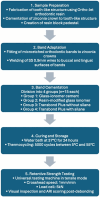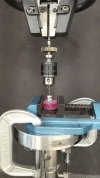Influence of cement type on the bond strength of orthodontic bands to zirconia crowns
- PMID: 40102836
- PMCID: PMC11917105
- DOI: 10.1186/s12903-025-05615-0
Influence of cement type on the bond strength of orthodontic bands to zirconia crowns
Abstract
Background: This study evaluated the retentive strength and residual cement of orthodontic bands bonded to zirconia crowns using four cementation protocols: Glass-ionomer cement (GIC), Resin-modified glass ionomer cement (RMGIC), Transbond Plus Light Cure Band Adhesive without silane, and Transbond Plus with silane primer application.
Materials and methods: Sixty zirconia crowns were divided into four groups (15 each) and cemented with the respective cements. Each crown was mounted on a resin-based tooth-like structure and secured to a universal testing machine. Orthodontic bands were adapted to the crowns, and forces were applied to measure retentive strength. After debonding, the remaining cement was assessed using the Adhesive Remnant Index (ARI). Specimens underwent thermocycling (5,000 cycles between 5 °C and 55 °C) to simulate oral conditions.
Results: The mean retentive strength was 1.23 MPa. Group 4 (Transbond Plus with silane) exhibited the highest strength (1.44 MPa), while group 1 (GIC) demonstrated the lowest (0.85 MPa). Cementation protocol significantly influenced retentive strength, with groups 2 (RMGIC) and 4 showing superior results to groups 1 and 3 (Transbond Plus without silane).
Conclusion: The cement type and protocol employed significantly affect the shear-peel bond strength of orthodontic bands cemented to zirconia crowns. RMGIC and Transbond Plus, especially with silane, provide superior retention compared to GIC.
Keywords: Cementation protocol; Orthodontic bands; Retentive strength; Zirconia crowns.
© 2025. The Author(s).
Conflict of interest statement
Declarations. Ethics approval and consent to participate: The research did not involve any human or animal subjects, and therefore, ethical approval or consent forms were not required. Consent for publication: Not applicable. Competing interests: The authors declare no competing interests. Clinical trial number: Not applicable.
Figures


Similar articles
-
Resin-modified glass ionomer, modified composite or conventional glass ionomer for band cementation?--an in vitro evaluation.Eur J Orthod. 2003 Dec;25(6):609-14. doi: 10.1093/ejo/25.6.609. Eur J Orthod. 2003. PMID: 14700267
-
Effect of thermocycling with or without 1 year of water storage on retentive strengths of luting cements for zirconia crowns.J Prosthet Dent. 2015 Jun;113(6):609-15. doi: 10.1016/j.prosdent.2014.12.001. Epub 2015 Mar 18. J Prosthet Dent. 2015. PMID: 25794911
-
Effect of Sandblasting and Type of Cement on the Bond Strength of Molar Bands on Stainless Steel Crowns.J Dent Child (Chic). 2015 May-Aug;82(2):64-9. J Dent Child (Chic). 2015. PMID: 26349792
-
The effect of retentive groove, sandblasting and cement type on the retentive strength of stainless steel crowns in primary second molars--an in vitro comparative study.J Indian Soc Pedod Prev Dent. 2012 Jan-Mar;30(1):19-26. doi: 10.4103/0970-4388.95570. J Indian Soc Pedod Prev Dent. 2012. PMID: 22565513
-
In vitro retentive strength of zirconium oxide ceramic crowns using different luting agents.J Prosthet Dent. 2005 Jun;93(6):551-8. doi: 10.1016/j.prosdent.2005.04.011. J Prosthet Dent. 2005. PMID: 15942616
References
-
- Caglaroglu M, Sukurica Y, Gurel HG, Keklik H. A comparison of shear bond strengths of six orthodontic cements. J Orthodontic Res. 2014;2(1):17.
-
- Fricker JP. A 12-month clinical comparison of resin-modified light-activated adhesives for the cementation of orthodontic molar bands. Am J Orthod Dentofac Orthop. 1997;112(3):239–43. - PubMed
-
- Williams P, Sherriff M, Ireland A. An investigation into the use of two polyacid-modified composite resins (compomers) and a resin-modified glass poly(alkenoate) cement used to retain orthodontic bands. Eur J Orthod. 2005;27(3):245–51. - PubMed
-
- Millett DT, Glenny AM, Mattick RC, Hickman J, Mandall NA. Adhesives for fixed orthodontic bands. Cochrane Database Syst Reviews. 2016;(10).
MeSH terms
Substances
LinkOut - more resources
Full Text Sources

